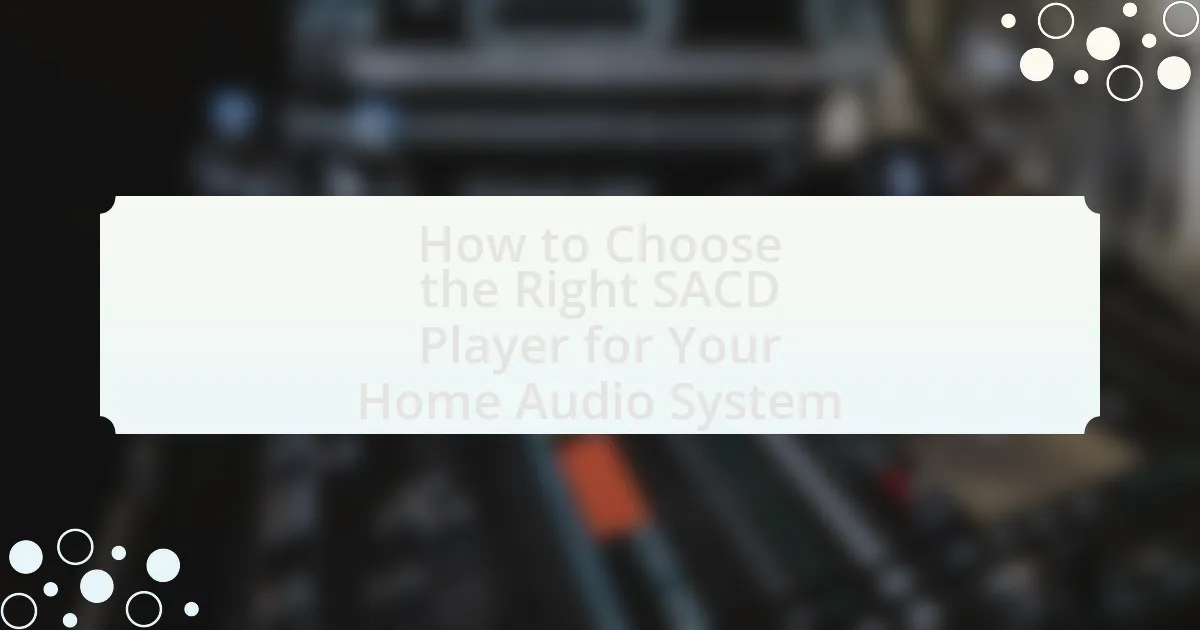The article focuses on how to choose the right SACD player for home audio systems, detailing the features and specifications that distinguish SACD players from standard CD players. It explains the technical advantages of SACD technology, including Direct Stream Digital (DSD) encoding and multi-channel audio capabilities, which contribute to superior sound quality. Key considerations for selecting an SACD player are outlined, such as compatibility with various audio formats, the importance of high-quality digital-to-analog converters (DACs), and the impact of build quality on performance. Additionally, the article addresses common misconceptions about SACD players and provides practical tips for integrating and optimizing the player within an existing audio setup.
What is an SACD Player?

An SACD player is a device designed to play Super Audio CDs, which are high-resolution audio discs that offer superior sound quality compared to standard CDs. SACD players utilize a technology called Direct Stream Digital (DSD) to deliver audio with greater detail and dynamic range, making them popular among audiophiles. The format was developed by Sony and Philips and was introduced in 1999, allowing for both multi-channel and stereo playback. This capability enhances the listening experience by providing a more immersive soundstage.
How does an SACD Player differ from a standard CD player?
An SACD player differs from a standard CD player primarily in its ability to play Super Audio CDs, which offer higher audio resolution and quality. SACD players utilize a different format that supports both stereo and multi-channel audio, providing a more immersive listening experience compared to the standard CD format, which is limited to 16-bit/44.1 kHz audio. Additionally, SACD players can read DSD (Direct Stream Digital) audio, which is a key feature of SACDs, allowing for a more detailed sound reproduction. This capability is supported by the fact that SACDs can store more audio data than standard CDs, which typically hold around 700 MB of data, while SACDs can hold up to 8.5 GB in dual-layer format.
What are the technical specifications that set SACD players apart?
SACD players are distinguished by their ability to play Super Audio CDs, which utilize a higher sampling rate and bit depth compared to standard CDs. Specifically, SACD employs Direct Stream Digital (DSD) encoding, which operates at a 2.8224 MHz sampling rate and 1-bit depth, allowing for a more detailed and nuanced audio reproduction. Additionally, SACD players often feature multi-channel audio capabilities, supporting up to six channels for surround sound, unlike traditional CD players that typically offer stereo output. The inclusion of high-quality digital-to-analog converters (DACs) further enhances audio fidelity, with many SACD players utilizing advanced DAC technologies to minimize distortion and improve sound clarity. These technical specifications collectively contribute to the superior audio performance that sets SACD players apart from standard CD players.
Why is SACD considered a high-resolution audio format?
SACD is considered a high-resolution audio format because it utilizes Direct Stream Digital (DSD) encoding, which offers a sampling rate of 2.8224 MHz, significantly higher than the standard CD’s 44.1 kHz. This higher sampling rate allows for greater detail and accuracy in sound reproduction, resulting in a more immersive listening experience. Additionally, SACD supports multi-channel audio, enhancing the spatial quality of music. The combination of DSD encoding and multi-channel capabilities solidifies SACD’s status as a high-resolution audio format.
What are the key features to look for in an SACD Player?
Key features to look for in an SACD player include high-resolution audio support, compatibility with various disc formats, and robust digital-to-analog converters (DACs). High-resolution audio support ensures that the player can deliver superior sound quality, often up to 24-bit/192kHz. Compatibility with various disc formats, including CD, SACD, and DVD-Audio, allows for versatile playback options. Additionally, high-quality DACs are crucial for converting digital audio signals into analog, significantly impacting sound fidelity. These features collectively enhance the listening experience and ensure the player meets modern audio standards.
How does the DAC (Digital-to-Analog Converter) impact sound quality?
The DAC (Digital-to-Analog Converter) significantly impacts sound quality by converting digital audio signals into analog signals, which are essential for playback through speakers or headphones. A high-quality DAC can enhance clarity, detail, and dynamic range in audio reproduction, while a lower-quality DAC may introduce distortion, noise, or loss of fidelity. Research indicates that the performance of the DAC directly correlates with the overall listening experience, as evidenced by studies showing that listeners can perceive differences in sound quality based on the specifications and design of the DAC used in audio systems.
What role does build quality play in the performance of an SACD Player?
Build quality significantly impacts the performance of an SACD player by influencing durability, sound quality, and overall functionality. High-quality materials and construction reduce vibrations and interference, which can lead to clearer audio reproduction. For instance, a well-built SACD player often features robust chassis designs that minimize resonance, thereby enhancing the fidelity of the sound output. Additionally, components such as high-grade capacitors and precision-engineered mechanisms contribute to more reliable playback and longevity. Studies have shown that players with superior build quality tend to deliver a more consistent and immersive listening experience, validating the importance of this aspect in selecting an SACD player.
Why is compatibility important when choosing an SACD Player?
Compatibility is crucial when choosing an SACD player because it ensures that the player can effectively work with your existing audio equipment and media formats. An SACD player must support various audio formats, including standard CDs and high-resolution SACDs, to provide versatility in playback. Additionally, compatibility with your home audio system, such as amplifiers and speakers, is essential for optimal sound quality and performance. For instance, if an SACD player lacks the necessary outputs or connections, it may not integrate seamlessly with your setup, leading to subpar audio experiences. Therefore, verifying compatibility with both media formats and audio components is vital for achieving the best possible sound quality and functionality in your home audio system.
What formats should an SACD Player support for optimal use?
An SACD player should support Super Audio CD (SACD) format, CD-DA (standard audio CD), and DSD (Direct Stream Digital) for optimal use. The SACD format allows for high-resolution audio playback, while CD-DA ensures compatibility with standard CDs. Supporting DSD enables the player to handle high-quality audio files, which is essential for audiophiles seeking superior sound quality. These formats collectively enhance the versatility and performance of the SACD player in a home audio system.
How does multi-channel audio capability enhance the listening experience?
Multi-channel audio capability enhances the listening experience by providing a more immersive sound environment. This technology allows sound to be distributed across multiple channels, creating a three-dimensional audio landscape that simulates real-life acoustics. For instance, in a multi-channel setup, sounds can come from various directions, making the listener feel as if they are part of the performance rather than just an observer. Research indicates that multi-channel audio can significantly improve spatial awareness and emotional engagement in music and film, leading to a richer overall experience.
What factors should you consider when selecting an SACD Player?

When selecting an SACD player, consider sound quality, compatibility, build quality, and features. Sound quality is paramount; look for players with high-quality DACs and support for various audio formats to ensure optimal playback. Compatibility is crucial; ensure the player can handle both SACD and standard CD formats, as well as other digital audio formats if needed. Build quality affects durability and performance; a well-constructed player often provides better sound isolation and longevity. Lastly, features such as HDMI output, digital inputs, and upscaling capabilities can enhance your listening experience and integration with other audio equipment.
How does your existing audio system influence your choice of SACD Player?
Your existing audio system significantly influences your choice of SACD player by determining compatibility and performance optimization. For instance, if your audio system includes high-end speakers and an advanced amplifier, selecting a SACD player with superior digital-to-analog conversion capabilities will enhance sound quality. Additionally, the connectivity options of your existing system, such as HDMI or analog outputs, dictate the type of SACD player you should consider to ensure seamless integration. Therefore, understanding the specifications and limitations of your current audio components is crucial for making an informed SACD player choice that maximizes audio fidelity and system synergy.
What types of connections should you prioritize for compatibility?
You should prioritize HDMI, optical, and analog connections for compatibility with your home audio system. HDMI connections support high-definition audio formats and video, making them ideal for modern systems. Optical connections provide a digital audio signal that minimizes interference, while analog connections are essential for older equipment that may not support digital formats. These connection types ensure that your SACD player can integrate seamlessly with various audio components, enhancing overall sound quality and performance.
How can the size and design of an SACD Player affect your setup?
The size and design of an SACD player can significantly impact your audio setup by influencing placement options and aesthetic integration. A larger SACD player may require more space on your audio rack, potentially limiting the arrangement of other components and affecting airflow, which is crucial for optimal performance. Additionally, the design, including materials and finish, can either complement or clash with existing equipment, impacting the overall visual coherence of your setup. For instance, a sleek, modern SACD player can enhance a contemporary audio system, while a vintage design may suit a classic setup better.
What is your budget for an SACD Player?
The budget for an SACD player typically ranges from $300 to over $5,000, depending on the brand, features, and audio quality. For instance, entry-level models like the Sony SCD-CE595 are available around $300, while high-end options such as the Marantz SA-10 can exceed $5,000. This price range reflects the varying levels of technology and sound performance available in the market, allowing consumers to choose based on their specific audio needs and preferences.
How do price ranges correlate with features and performance?
Price ranges directly correlate with features and performance in SACD players, as higher-priced models typically offer advanced technologies, superior build quality, and enhanced audio capabilities. For instance, budget SACD players may lack features such as high-resolution audio support, advanced digital-to-analog converters, or robust connectivity options, while premium models often include these enhancements, resulting in better sound quality and user experience. Research indicates that consumers can expect a significant improvement in audio fidelity and additional features, such as multi-channel playback and streaming capabilities, as the price increases, validating the relationship between cost and performance in the audio equipment market.
What are some recommended brands and models within different price ranges?
Recommended brands and models for SACD players across different price ranges include Sony, Marantz, and Cambridge Audio. In the budget category, the Sony SCD-CE595 offers good performance at an affordable price, typically around $200. For mid-range options, the Marantz SA8005 is highly regarded, priced around $1,200, and known for its excellent sound quality and build. In the high-end category, the Esoteric K-01XD stands out, with a price tag of approximately $12,000, recognized for its superior audio fidelity and advanced technology. These brands and models are well-reviewed and widely recommended by audio enthusiasts and experts.
What are the common misconceptions about SACD Players?
Common misconceptions about SACD players include the belief that they only play SACD discs, that they provide no improvement over standard CD players, and that they are obsolete due to digital streaming. In reality, SACD players can also play standard CDs and other formats, offering enhanced audio quality through high-resolution audio capabilities. Furthermore, studies have shown that SACD’s DSD (Direct Stream Digital) format can deliver superior sound quality compared to traditional PCM (Pulse Code Modulation) used in CDs, making them a valuable addition for audiophiles. Lastly, while streaming services are popular, many enthusiasts still prefer the tangible quality and experience of physical media, ensuring that SACD players remain relevant in high-fidelity audio systems.
Why do some people believe SACD Players are not worth the investment?
Some people believe SACD players are not worth the investment due to the limited availability of SACD titles and the perception that standard CDs or digital formats provide sufficient audio quality for most listeners. The market for SACDs is relatively small, with fewer releases compared to traditional CDs, which diminishes the appeal for consumers. Additionally, many audiophiles argue that high-resolution digital formats, such as FLAC or streaming services, offer comparable or superior sound quality without the need for specialized hardware, making SACD players seem less essential.
How can understanding the technology dispel these myths?
Understanding the technology behind SACD players can dispel myths by clarifying misconceptions about sound quality and compatibility. For instance, many believe that SACD players only play SACD discs, but in reality, most models also support standard CDs and other formats, enhancing their versatility. Additionally, the advanced DSD (Direct Stream Digital) format used in SACDs provides superior audio fidelity compared to traditional formats, which counters the myth that all digital music is of equal quality. By educating consumers on these technical aspects, they can make informed decisions and appreciate the true capabilities of SACD players in their home audio systems.
How can you ensure you make the right choice in an SACD Player?

To ensure you make the right choice in an SACD player, evaluate key features such as audio quality, compatibility, and build quality. High-resolution audio support is essential, as SACD players should handle DSD formats effectively to deliver superior sound. Additionally, check for compatibility with various disc formats, including CD and DVD-Audio, to maximize versatility. Build quality matters; a well-constructed player typically offers better durability and performance. Researching user reviews and expert opinions can also provide insights into reliability and sound performance, helping you make an informed decision.
What are the best practices for testing an SACD Player before purchase?
To effectively test an SACD player before purchase, one should listen to a variety of SACD discs across different genres to evaluate sound quality and performance. This practice allows potential buyers to assess the player’s audio fidelity, dynamic range, and clarity, which are critical for high-resolution audio formats like SACD. Additionally, checking the player’s compatibility with various formats, including CD and DVD-Audio, ensures versatility in playback options. Observing the build quality and user interface can also provide insights into the overall user experience. Testing the player in a controlled environment, ideally with familiar tracks, helps in making a more informed decision.
How can you evaluate sound quality during a demonstration?
To evaluate sound quality during a demonstration, listen for clarity, balance, and detail in the audio output. Clarity refers to how well individual instruments and vocals can be distinguished, while balance assesses the evenness of sound across different frequencies, ensuring no part is overpowering. Detail involves the ability to hear subtle nuances in the music, such as the texture of instruments or the ambient sounds in a recording.
Additionally, consider the dynamic range, which is the difference between the quietest and loudest sounds, as a wider dynamic range typically indicates better sound quality. Listening in a controlled environment, free from external noise, further enhances the evaluation process.
What should you listen for in terms of audio performance?
In terms of audio performance, you should listen for clarity, dynamic range, and tonal balance. Clarity ensures that individual instruments and vocals are distinct and easily identifiable, which is crucial for an immersive listening experience. Dynamic range refers to the difference between the quietest and loudest sounds, allowing for a more expressive performance; a wider dynamic range enhances the emotional impact of music. Tonal balance involves the evenness of sound across different frequencies, ensuring that bass, midrange, and treble are well-represented without any one frequency overpowering the others. These elements collectively contribute to a high-quality audio experience, making them essential factors to consider when evaluating SACD players.
What are some tips for integrating your new SACD Player into your home audio system?
To integrate your new SACD player into your home audio system, first ensure that your player is connected to a compatible receiver or amplifier that supports SACD playback. This is crucial because not all audio systems can decode the high-resolution audio formats SACDs offer. Next, use high-quality interconnect cables, such as HDMI or analog RCA cables, to connect the SACD player to your audio system, as this will help maintain audio fidelity. Additionally, configure your audio settings to optimize sound quality; for instance, select the correct input source on your receiver and adjust any sound processing settings to enhance the SACD playback experience. Finally, consider speaker placement and room acoustics, as these factors significantly influence sound quality, ensuring that your setup allows for optimal listening conditions.
How can you optimize your setup for the best sound experience?
To optimize your setup for the best sound experience, ensure that your audio components are properly matched and positioned. This involves selecting an SACD player that complements your amplifier and speakers, as well as placing them in an acoustically favorable environment. For instance, positioning speakers at ear level and away from walls can significantly enhance sound clarity and depth. Additionally, using high-quality cables and ensuring that your components are free from interference can further improve audio fidelity. Research indicates that proper speaker placement can increase perceived sound quality by up to 30%, demonstrating the importance of setup in achieving optimal sound performance.
What common troubleshooting steps should you know after installation?
Common troubleshooting steps after installation include checking connections, ensuring the power supply is functional, and verifying settings. First, inspect all cables to confirm they are securely connected to both the SACD player and the audio system. Next, ensure the power outlet is operational by testing it with another device. Finally, review the player’s settings to confirm they are configured correctly for your audio system, such as selecting the appropriate input source. These steps are essential for resolving common issues that may arise post-installation, ensuring optimal performance of the SACD player within your home audio system.

Leave a Reply